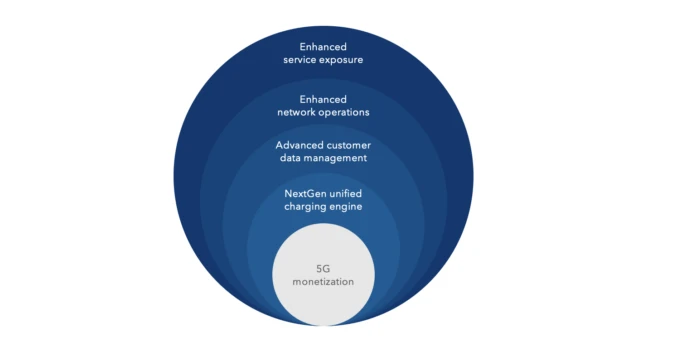
By Sean Kinney, Editor in Chief September 27, 2024
Collected at: https://www.rcrwireless.com/20240927/fundamentals/what-is-the-role-of-bss-evolution-in-5g-monetization
As 5G Standalone ramps, monetization hinges on marrying customer experience with network insights
While digital transformation has been a buzzword in many different industries for some time, the rubber is meeting the road, so to speak, in the world of telecoms. The pressing need to monetize 5G while modernizing network hardware and software in a way that meets needs around leveraging AI in a flexible, future-ready manner has, generally, caused a transition from vendors pushing operators to digitalize to the buyer’s market pulling operators forward.
Sandeep Singh, senior vice president and general manager of Mavenir’s Digital Business Enablement solutions, rightly described BSS as “the way [operators] touch the customer. As they grow more, they become risk-averse…They don’t want to change the way the customer perceives them.” He contrasted this with how hyperscalers like Amazon or Meta leverage “customer intelligence” to be “adaptive and fast…They know what their customer needs before the customer realizes it.”
As operators try to translate data into outcomes (increasingly with help from AI), Singh highlighted two pillars. “One is operational excellence. They are looking to optimize and reduce costs. They have monolithic systems and they are not able to make changes fast enough. They are not able to bring automation because the systems are very hard-coded…The second that we are seeing now is that operators are trying to go digital rather than [relying on] point-of-sale as a way of attracting customers. They want to engage with their customers and subscribers in a digital mode…Behind that they want to bring in a lot of intelligence.”
A brief point from Singh on his operational excellence pillar, and around the difficulties in replacing foundational software systems that contain crucial business logic: “They want to bring change into a monolithic architecture. The reason why [that’s a slow process] is it’s expensive and time-consuming. And if they bring a small change into the software they have to retest everything. They don’t know how all of the software is interdependent.”
On the second pillar of digitalization to drive revenue growth, “Operators are trying to launch new digital brands, even second brands, where they are going after certain segments,” Singh said. To do that, “They have to go into those monolithic systems, and the cost to build [bespoke] plans is too expensive because they have to make changes throughout the software stack…You need to be able to play with the commercial models without having to do hard-coding changes.”
In a recent webinar, available on-demand here, Singh laid out 5G monetization levers—network slicing, API monetization, mobile edge computing, fixed wireless access, and the internet of things—and detailed Mavenir’s five-step approach:
- Define the value of a particular use case
- Convey the value through a modern customer journey that makes buying easy
- Digitally onboard customers, automate ordering and fulfillment and provide real-time notifications
- Measure the value and configure rating rules with a no-code approach
- Iterate on the above bullets; “Experiment fearlessly to achieve the perfect business model,” Singh said.
- Finally, replicate the use case for other industries on top of a flexible use case agnostic platform or platforms
As for the building blocks of that use case agnostic platform, think of nested concentric circles (moving from the edge of the circle to the interior, and see feature image above): enhanced service exposure, enhanced network operations, advanced customer data management, next-generation unified charging engine, and 5G monetization. The overarching idea is to build customer-facing solutions that use data and AI to understand intent, and pair that with a flexible, adaptive network that can dynamically translate that intent into a service.
Mavenir’s Digital Business Enablement portfolio includes:
- Digital BSS for customer and product management, and billing
- Converged charging for 5G monetization, API and network slice charging, and charging and mediation for 2G, 3G, 4G and 5G
- Digital marketplace for enterprise/B2B and partner settlement engine
Looking at priority vectors for 5G monetization, Mavenir is working to help operators monetize network slicing as supported by 5G Standalone (SA) networks and APIs. For slicing, Singh said Mavenir is fostering customer stickiness by going beyond merely provisioning a slice to monitoring the slice using network telemetry to guarantee service delivery. This gets a core (pun intended) issue around the slow move to 5G SA. “If they’re not able to charge a differential rate, the cost they incur to bring 5G SA, they’re not able to recover it. Unless you have a way to reach the customer and tell that customer that you are getting a differentiated value…that’s why it does slow down in some of the operators.”
Given the arc of 5G monetization, or lack thereof, and why the need for BSS/OSS modernization is just now coming to the fore, Singh said it’s because “we’re network people. Once we have a solution ready, all the trials are done, it’s only then that [operators] think they need to go approach their IT counterparts to see that they can monetize the service. Then they take their sweet time…We want to bridge that gap.”

Leave a Reply